Content can be downloaded for non-commercial purposes, such as for personal use or in educational resources.
For commercial purposes please contact the copyright holder directly.
Read more about the The Creative Archive Licence.
Description
Date: 30 March 1915
Transcript:
[1]
UNDER FALSE FLAG.
Evidence at the Inquest
FALABA S CHIEF OFFICER S STORY.
Steam Drifter's Effort to Ram Submarine.
(By Our Own Reporter.)
At the inquest at Milford to-day on the bodies of eight people drowned by the sinking of the Falaba on Sunday, a verdict of death due to exposure following the sinking of the vessel by a German submarine was returned. The inquest on eight victims of the Falaba tragedy was conducted by the Pembrokshire Coroner, Mr. H. G. Price, at the County Sessions House, Milford Haven to-day.
So far only eight bodies have been recovered, among them being that of a male passenger, about 27 years of age, which up to this morning remained unidentified.
Those upon whom inquests were held were Captain Frederick J. Davies, Thomas Evans, J. Dawson, Leslie Blakeny, Walter Ernest Wallace, Frank Ellison, John Meyer and another.
Mr. W. H. Bryant, solicitor, Pembroke, represented the Admiralty, and Mr. R T. P. Williams, Haverfordwest., was for the owners of the Falaba, and Lieut. Cresigny, who is in charge of the minesweepers at Milford, and Chief Inspector Morgan were also present on behalf of the Admiralty.
The Coroner, in opening, stated that the Falaba left Liverpool on Saturday afternoon for West Africa. All seemed to have gone well until about mid-day on Sunday, when what ultimately proved to be a German submarine was sighted somewhere about 55 miles south-west of the Smalls. Some sort of a warning was apparently given, but before the people were able to get clear of the ship a torpedo was fired, with the result that these eight people, and a good many others, lost their lives.
After hearing the evidence he did not think the jury would have any difficulty in arriving at the cause of their deaths.
Owners' Sympathy.
Mr. R. T. P. Williams, on behalf of Messrs. Elder Dempster and Co., expressed deep sympathy with the families of those who had lost their lives, and with the survivors, who must have gone through a trying and distressing time.
On behalf of the Admiralty, Mr. Bryant said he wished to associate himself with the statements, and express the Admiralty's deep sympathy in the case.
Chief Officer's Story.
Captain Walter Cameron Baxter, chief officer of the Falaba, gave a graphic narrative in the course of his evidence.
He said the ship left Liverpool on Saturday afternoon for the West Coast of Africa. She was a ship of 3,011 tons register. The crew was roughly 100, and there were 150 passengers. The cargo was a general one, consisting chiefly of Government stores. All went well until 11.40 on Sunday. About that time witness and the third officer were on watch. His colleague first sighted the submarine three miles away, two points above the starboard beam. She was flying a flag which we observed to be the white ensign, but she afterwards hauled it down. The captain put on full speed ahead and altered his course. At the same time the crew were ordered to stand by the boats. The submarine was about a quarter of an hour overhauling us. She was a boat of 16 to 18 knots, and we were only 13 knots. When we became suspicious of the nationality of the craft our wireless operator sent out a message that a submarine flying the white ensign was following the ship. We were at this point 40 to 50 miles south-west of the Smalls.
"We stopped immediately, and made to abandon the ship, and it was now that the submarine hoisted the German flag. 'Stop and abandon ship' was her signal. We were quite close to her at this time."
The Coroner: Did you obey the signal?—No, not for a time.
The Coroner: Then she put up another signal "Stop or I will fire into you"?—Yes.
Witness added: "The captain asked for my advice, and I said, 'Yes, seeing there are many passengers on board. We stand no chance." Then the liner was stopped.
"We got out all the boats." continued witness "and the submarine did not speak to us afterwards. Five boats were sent out before we were torpedoed, each of which was capable of holding 50 or 60 passengers. The first boat capsized, and two otrer boats were got away with all possible speed. Everything that would float was thrown overboard."
No Warning Given.
Witness was at this point questioned by the Coroner as to the circumstances of the sinking of the first lifeboat, and was understood to reply it was caused by some passengers jumping into it. The submarine, he continued, steamed from the port to the starboard quarter, and getting into position fired the torpedo.
The Coroner: Did she give you any warn ing that she was about to torpedo you?
Witness: None whatever. After the ship was actually torpedoed there were four boats which did not get away.
The Coroner: I suppose the submarine could see them herself?
Witness: I could not say. There was no number on the submarine, which could hardly be detected as she was similar in colour to the water.
Beyond these two signals, "Abandon ship" and "Stop or I fire," did you receive any communication?—None.
The chief officer, continuing, said the crew of the submarine came up on deck, and many of them were dressed in khaki. They made no attempt at rescue. The first lifeboat passed quite close to them. The submarine went away almost at once.
Witness was supervising the launching of the boats. "I was putting the last forty persons into a boat," he said, "when the explosion of the torpedo blew us to pieces. I remained on board until the liner sank ten minutes after she was torpedoed."
Captain's Last Act.
The Coroner: When did you last see the captain?—He brought a lady along to me and said she was the last lady, and asked me to put her in the gig. I never saw him after that.
Where did the torpedo strike the ship?—Right opposite the wireless room.
Was there an explosion?—Yes, a terrible l explosion.
Witness stated that he was in the water for about two hours before being picked up. Most of the crew were Englishmen.
The Coroner: How long from the time you stopped the ship did they fire?—About five minutes.
Replying to Mr. Bryant, witness said that the submarine was about 150 yards away from the Falaba when she fired.
I suppose it was quite clear to the submarine that all the passengers and crew had not left?
Witness added that it was rather choppy, but the weather was very clear.
Passengers Killed.
Did the torpedo actually kill some of the passengers?—I should think it did.
Had the submarine any guns?
They had two on deck, one forward and one aft.
Can you say what colour was the submarine?-—It. was about the same colour as the water.
It was very hard to identify her?
Did she submerge after she fired?—I was too busy to notice, but I think she did.
Were the guns manned?—There were about 14 men on deck altogether. There wore none at the guns when they came up.
Coroner: Are you sure that these men on the submarine were in khaki, and not in yellow oilskins?—They were not in yellow oilskins.
Sergeant Treharne produced a letter on the body of J. Dawson, pointing to his identity. On the body of Corpl. Wallace was also found a document proving to his identity. On the other unidentified man was £10 in gold, a gold pin of a horse-shoe shape, a silver match-box, and a small silk handerchief. Witness added that he took some of the passengers and crew to have a look at him, but they failed to identify him.
Chased the Pirate.
Captain George Wright, of the Lowestoft steam drifter Eileen Emma, who went to the rescue of the passengers and crew, said when he first sighted the Falaba and the submarine they were six or seven miles apart.
Coroner: "ou must have seen the submarine before the Falaba. saw her?—Yes, I saw the submarine some time before that. I saw the conning tower of the submarine half a mile a head [sic] of us, and we chased her. She was then going in a south-easterly direction.
Sank in Ten Minutes.
When the submarine torpedoed the Falaba, Captain Wright continued, the Eileen Emma was 300 yards away, and the steamer sank in about ten minutes. As soon as she fired the torpe the submarine proceeded to the south-east. She remained near the scene until the Falaba sank, and then raced south-west.
Did you go up to the steamer?—Yes, and picked up as many people as we could.
How many did you pick up?—About 50 out of the water, and we took up the rest from the boats, including the captain. Out of these, six others died on board the Eileen Emma.
Witness added there was a choppy sea but at the spot the water was pretty smooth, as there was oil over it.
Replying to Mr. Bryant, witness said that the disaster happened about one o'clock. He noticed that the submarine flew flags, but he could not ascertain them.
Mr. Bryant: Did the submarine make any effort at all to rescue any of the passengers?—No, sir
Witness added that the submarine carried guns, but they were not manned. About an hour after the disaster four other drifters arrived, the Whenlock, George Baker, Orient II., and Emulate.
Replyng [sic] to a juryman, witness said they did not see any Government patrol boats. He came up to the destroyers about 25 miles away.
Heard Reports.
Dennis Randal.son, skipper of the Whenlock said that they thought they heard reports, and after coming on deck saw the steamer about six or seven miles away. They went towards her. When within half a mite of her they saw the small boats. They picked up eight persons, two of whom died afterwards.
(Continued on page Five).
[5]
TRAWLERMEN PRAISED.
COURAGEOUS ATTITUDE IN THE FACE OF DANGER
TRUE TO TRADITIONS
(Continued from Page One).
Meical Evidence.
Dr David Reeves, Milford Haven, said the injuries to the eight men were only slight. The cause of death was exhaustion due to exposure.
The Coroner said that it was a distressing case. This ship was leaving England, and without any pretence of examination and giving no time for all on beard to get clear, she was torpedoed.
"If this is not piracy and murder on the high seas, I do not know what would constitute such an act." He advised the jury to return a verdict that the men met their death through the steamer being attacked by a German submarine, and leave the matter there. If the authorities were fortunate enough to capture the submarine, although no one seemed to know her, he hoped they would mete out such punishment that would be commensurate wtih [sic] such a dastardly act as caused the death of these unfortunate people.
Traditions of British Seamanship.
Mr. Williams said the officers and crew of the Falaba seemed to have acted up to the best traditions of British seamanship. The services rendered by the Eileen Emma were very great. She undoubtedly saved a large number of people from death. It showed that seamen are at all times ready to risk their lives to render all the assistance they can.
Mr. Bryant said the Admiralty also wished to express their high appreciation of the action of the crew of Eileen Emma, and of the other steam trawlers that attended. They had behaved in a most creditable manner.
The Verdict.
The jury returned an unanimous verdict on the lines suggested by the Coroner, that the men died from exposure caused by the ship being torpedoed by a German submarine. The jury also expressed their appreciation of the conduct of the rescuers.
DEATH ROLL: 112.
The Press Association's Liverpool correspondent was officially informed at the ofices of Elder Dempster Line to-day, that the number of passengers and crew of the Falaba who are still to be accounted for is 104. To these must be added the seven identified bodies, including that of Captain Davies, commander of the doomed ship, which brings the total death roll to 112.
Source:
'Under False Flag.' The Cambria Daily Leader. 30 March 1915. 1, 5.

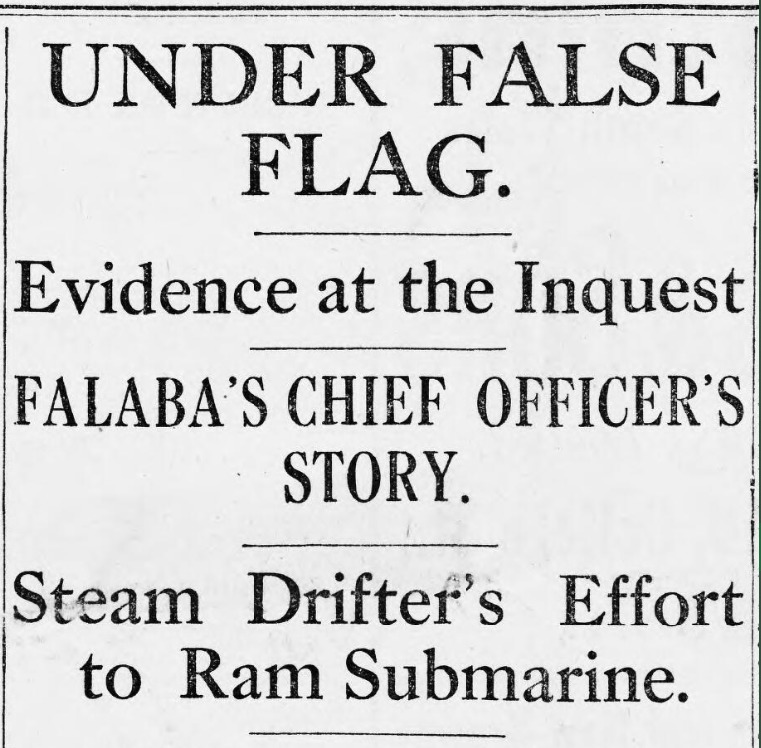





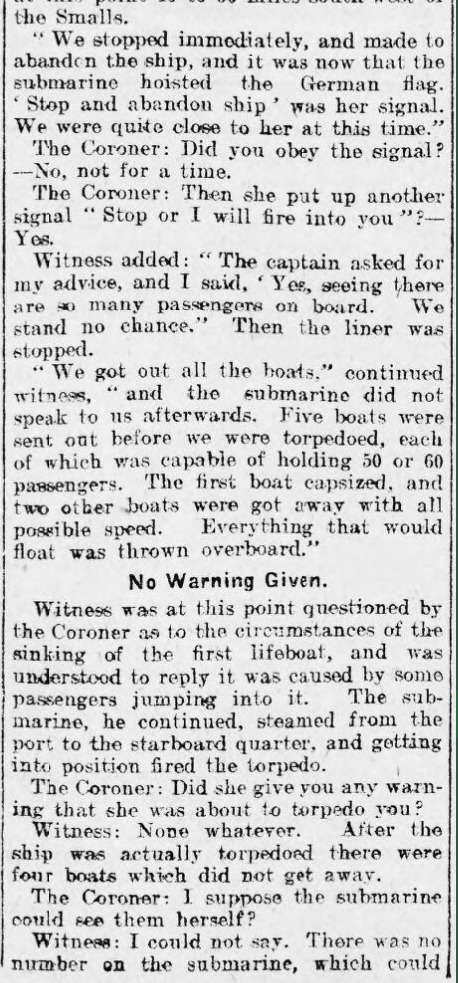

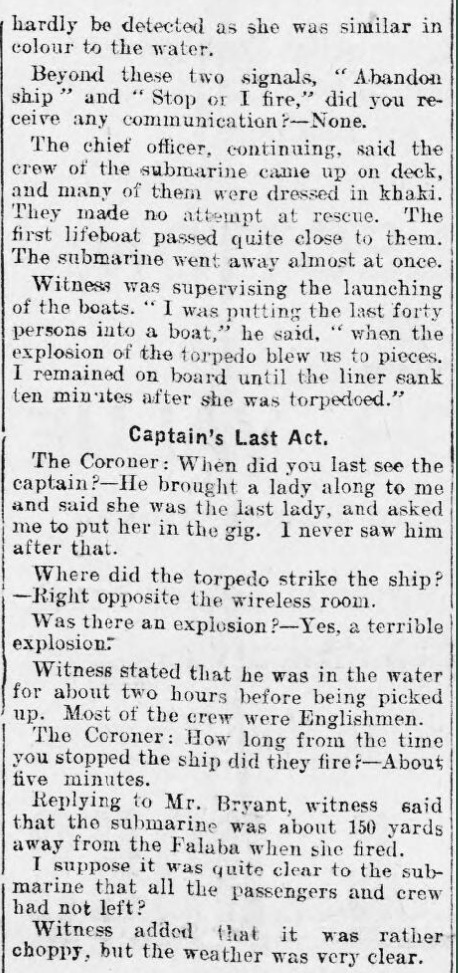

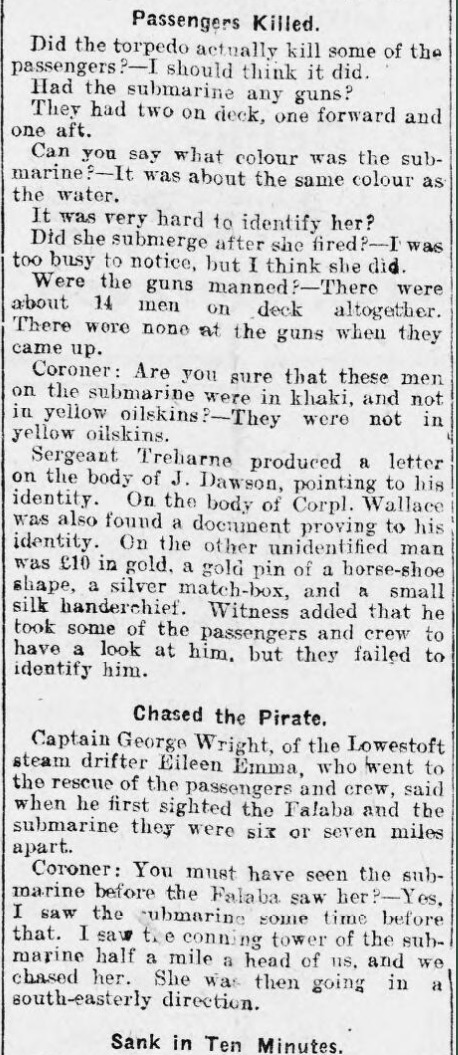

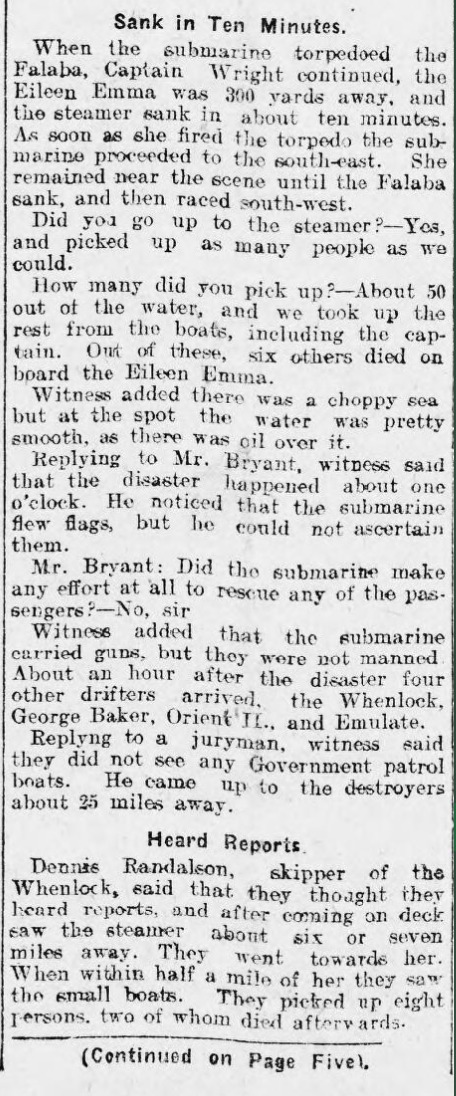



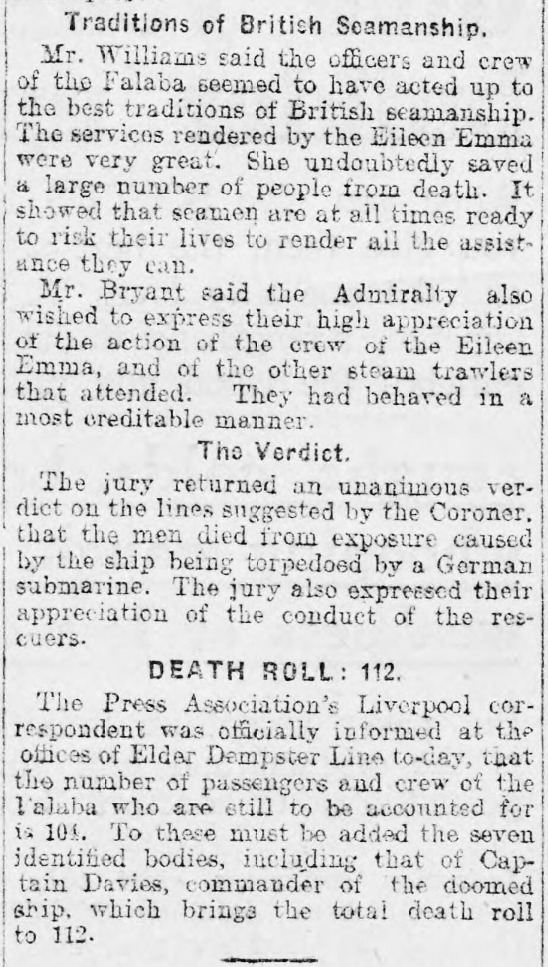



Do you have information to add to this item? Please leave a comment
Comments (0)
You must be logged in to leave a comment